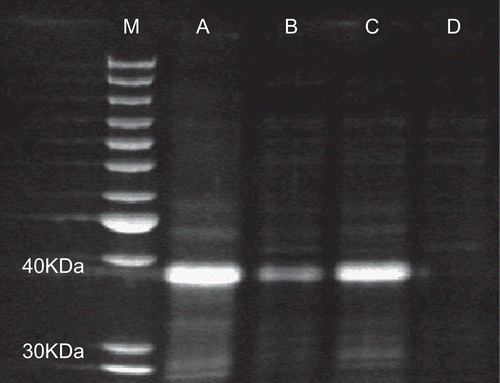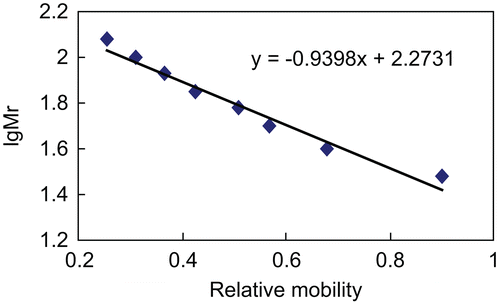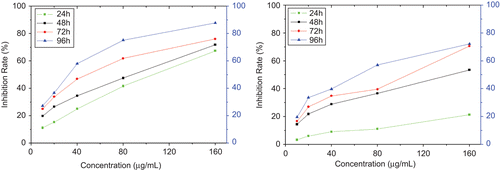Figures & data
Figure 1. The crude coelomic fluid of earthworm was characterized with SDS-PAGE. Lane M: protein ladder; lane A: the filtrated earthworm coelomic fluid (not ultrafiltration); lane B: the ultrafiltrated earthworm coelomic fluid (< 1000 KDa); lane C: the ultrafiltrated earthworm coelomic fluid (5 KDa1–000 KDa); lane D: the ultrafiltrated earthworm coelomic fluid (< 5 KDa).

Figure 2. Two main components (peak 1 and 2) were obtained after the gel chromatography of the ultrafiltrated earthworm coelomic fluid (5 KDa–1000 KDa) (left). The bioactive protein (peak 1) was collected after the ion exchange chromatography (right).

Figure 3. Standard curve related to the relative mobility and logarithm of standard molecular weight was established. The x-axis represents the relative mobility, and the y-axis represents the logarithm of the standard molecular weight of protein (protein ladder).

Figure 4. The purified earthworm proteins were characterized with SDS-PAGE. Lane M: protein ladder; lane A: the ultrafiltrated earthworm coelomic fluid (5 KDa–1000 KDa); lane B: peak 1 purified after the gel chromatography; C: peak 1 (ECFP with molecular weight of 38.6 KDa) purified after the ion exchange chromatography.

Table 1. Hemolytic activity of the ECFP on CRBC.
Table 2. Antibacterial activity of the ECFP on bacteria.
Figure 5. HeLa cells and LTEP-A2 cells were exposed to ECFP with final concentration of 10, 20, 40, 80, and 160 μg/mL for 96 h, and MTT method was performed for determining the cell proliferation. Every dosage was repeated three times. The ECFP (38.6 KDa) inhibited the proliferation of HeLa cells (left, IC50 77 μg/mL) and LTEP-A2 cells (right, IC50 126 μg/mL) in vitro compared with the control both in a time- and dose-dependent manner.
